Project MATCH Monograph Series
Series Editor: Margaret E. Mattson, Ph.D.
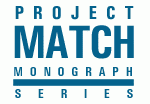
It has been more than a decade since the eighth volume of the Project MATCH Monograph Series was published. The initial purpose of this series of manuals was to disseminate methodology developed by the investigators of the multisite clinical trial Project MATCH (1990–1997), an initiative funded by the National Institute on Alcohol Abuse and Alcoholism (NIAAA). The Institute developed these materials with the hope that they would fill a gap in the published literature and would be useful for alcohol treatment researchers and clinicians. That prediction has proven to be accurate. Since the initial publication, the manuals have been reprinted many times and requested by users both in the United States and abroad. Several of the manuals have been translated into other languages for use in other countries, including China, France, and Spain. Requests for the manuals continue even now.
Because of the continued interest in the Project MATCH series, NIAAA has repackaged all eight volumes and made them available online. It is our hope that having this material available in electronic form will make the information even more useful and available to a wider audience.
Background
The Project MATCH manuals (Volumes 1–3), which focus on three forms of behavioral therapy, have been used in clinical practice as a teaching tool in therapist training and as behavioral platforms in clinical trials. The manuals are used in diverse settings, from public and private practices and academic research to pharmaceutical industry trials. Volumes 4–8 focus on assessment instruments and compliance to treatment regimens and research protocols and examine the results and analysis of the causal chains involved in addiction.
In the years following the Project MATCH study, the field has moved forward dramatically, both conceptually and methodologically. The core principles and much of the detail presented in the Project MATCH manuals remain solid and relevant. However, readers are encouraged to consult PubMed and other databases for new developments in the alcohol treatment field. Another source for treatment research and clinical practice information is the Project MATCH Web site, which catalogs publications derived from the Project MATCH experience from 1991 through 2003 (http://www.commed.uchc.edu/programs/health_services/match/).
Below we highlight some of the newer methodologies that have emerged in the past decade as they pertain to each manual.
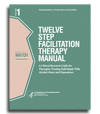
Volume 1: Twelve Step Facilitation Therapy Manual: A Clinical Research Guide for Therapists Treating Individuals With Alcohol Abuse and Dependence—The Twelve Step Facilitation intervention (Volume 1), which now is regarded as an evidence-based intervention, continues to be supported by numerous studies, both as a sole therapy and an adjunct treatment. This intervention has since been extended to an early recovery program for both alcoholism and addiction to other substances. Although there are a plethora of new clinical assessments and diagnostic scales, the Jellinek Assessment of Symptoms, which is included in the manual’s appendix, and the description of the phases of alcoholism that originated many years ago still deserve a place in the manual and continue to resonate with many clinicians. Brief forms of Twelve Step Facilitation and other adaptations have since been developed and are available from health care, social services staff, and specialists in diverse settings, including emergency departments and psychiatry practices. The Web sites of several treatment programs now feature Twelve Step Facilitation, and many training courses are available that offer continuing-education credits for psychologists, psychiatrists, social workers, and counselors.
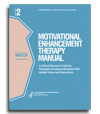
Volume 2: Motivational Enhancement Therapy Manual: A Clinical Research Guide for Therapists Treating Individuals With Alcohol Abuse and Dependence—Motivational Enhancement Therapy (MET) (Volume 2) remains one of the most highly requested of the volumes. MET has burgeoned into a widely used approach and has been extended to include interventions for other behaviorally driven health conditions, such as pregnancy. This approach is useful for both heavy and light drinkers, users of other substances, and a wide variety of age groups, including adolescents. Based on a nondirective approach, MET seeks to motivate the client to change his or her drinking behavior. The wide success of MET has debunked the myth that confrontation or direct persuasion is the most effective approach for substance abuse intervention. As with Twelve Step Facilitation, the literature shows strong evidence of MET’s effectiveness and efficacy, and numerous Web sites and training programs on this approach are available.
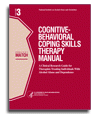
Volume 3: Cognitive-Behavioral Coping Skills Therapy Manual: A Clinical Research Guide for Therapists Treating Individuals With Alcohol Abuse and Dependence—The roots of Cognitive-Behavioral Coping Skills Therapy (CBT) actually predate Project MATCH. The manual draws heavily on material first published in 1989 by Dr. Peter Monti. The general framework and goals, although unchanged over the years, have seen progress. For example, CBT now is being applied to other diseases and disorders, including insomnia, bulimia, obsessive-compulsive disorder, anxiety, addiction, and depression. This therapy has proved especially useful for treating adolescents, as it enables the clinician to easily tailor the discussion to meet the needs of a younger patient. CBT also is providing promising results in group settings of patients with bipolar and panic disorders.
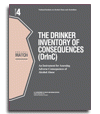
Volume 4: The Drinker Inventory of Consequences (DrInC): An Instrument for Assessing Adverse Consequences of Alcohol Abuse: Test Manual—Since the initial publication of this manual, this instrument has been adapted for online use. It also was evaluated as part of a Web-based brief motivational intervention, www.drinkerscheckup.com. In addition, a new version of DrInC was proposed recently that offers greater validity and usability. This self-administered family of instruments measures a range of social, personal, and psychological consequences of problematic alcohol use. Long and short forms are available. DrInC has been used to assess changes in drinking consequences during clinical trials and as a clinical tool to evaluate patient status at the start of treatment.
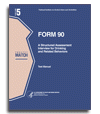
Volume 5: Form 90: A Structured Assessment Interview for Drinking and Related Behaviors: Test Manual—This manual was the first detailed publication on Form 90, a family of related instruments that generate both baseline and follow-up information. Form 90 is an extension of the Traditional Time Line Follow Back method, so named because it provided guidelines for assessing alcohol consumption for the previous 90 days. Among other additions, Form 90 introduced the Steady Pattern Chart to identify periods of time when the individual drank in a consistent fashion, thus obviating the need for day-by-day questioning for those periods. Electronic drink calculators, such as the Time Line Follow Back Standard Drink Unit Calculator, can now be used to convert raw data to standard drink units across a wide variety of beverage types and sizes and are useful for increasing the accuracy and consistency of data across multiple sites and users. This calculator has been used in several academic multisite clinical trials, Phase 2 NIAAA multisite clinical trials, as well as larger Phase 3 pharmaceutical trials.
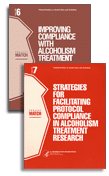
Volume 6: Improving Compliance With Alcoholism Treatment and Volume 7: Strategies for Facilitating Protocol Compliance in Alcoholism Treatment Research are companion volumes that address the issue of compliance. Both are compendia of strategies for enhancing the patient’s compliance with psychosocial treatments as well as the therapist’s compliance with treatment protocols. Volume 6 addresses communication strategies and therapist compliance (e.g., assuring treatment fidelity, setting goals, and establishing a healthy and trusting therapeutic relationship). Volume 7 includes facilitating protocol compliance in research settings (e.g., adherence to medication regimes and visit attendance).
Both manuals feature specific hands-on strategies for tracking and increasing attendance and educating participants. Advances in technology, such as modern software and online real-time data entry, have made the issue of compliance much easier to manage. Electronic medication dispensing and monitoring systems, developed using NIAAA Small Business Innovation Research (or SBIR) contracts, provide automated management of medications regimes for research and clinical situations. Most research sites now have automated tracking systems that schedule and track attendance and alert staff when patients have missed an appointment. Likewise, medication adherence has become easier with blister-card packaging that identifies missed doses.

Volume 8: Project MATCH: Hypotheses: Results and Causal Chain Analyses—This final volume offers a detailed accounting of the vision that shaped the hypotheses tested in Project MATCH. Each of the hypotheses required a rigorous specification of the postulated mechanisms of change, along with the statistical model to be used for analysis. In addition to presenting the a priori hypothesis and causal chain, the volume reports the results of tests from the chain of events in each of the causal models. Each step of every model was carefully examined to see where the postulated model was supported and where it failed. This approach was innovative at the time, both conceptually and statistically, and represented a methodological step forward in behavioral research.
The Project MATCH hypotheses were univariate in nature; that is, the magnitude of one patient characteristic was postulated to predict increased or decreased outcome, based on the rationale from results of previous smaller studies and theoretical feasibility. From today’s vantage, it is not surprising that the matching effects found were modest, given the complex mechanisms involved in behavior change. The science of understanding the mechanism of behavior change (MOBC) has advanced considerably in recent years. It is now common to see MOBC hypotheses as secondary outcomes for both behavioral and combination behavioral-pharmacologic studies. Work is actively underway to better understand the reasons for the high background rate of recovery seen in control conditions (the so-called placebo effect) and, more recently, why drinking behavior routinely improves between the time a patient first inquires about participating in a pharmacological clinical trial and when he or she receives the first dose of medication.
Next Steps
For many years NIAAA has had an active interest in studying how and why some people are able to stop drinking, whereas others cannot. Project MATCH laid the foundation for this research. And, in 2005, NIAAA brought renewed emphasis to this research question by hosting a 1-day, preconference satellite meeting entitled, “The Search for Mechanisms of Change in Evidenced-Based Behavioral Treatments.”The proceedings from this meeting were then published in a supplement to Alcoholism: Clinical and Experimental Research (October 2007, Vol. 31, No. 10) entitled, “The Search for Mechanisms of Behavior Change in Evidence-Based Behavioral Treatments for Alcohol Use Disorders.” (http://www.ncbi.nlm.nih.gov/pubmed/17880340)
Later that year, NIAAA sponsored two expert-panel workshops with the goal of laying the groundwork for the new NIAAA Strategic Plan to bring greater attention to the mechanisms of behavior change. In early 2006, NIAAA’s Extramural Advisory Board (EAB) reviewed the Strategic Plan and recommended three foundational activities:
- Release an R21 Request for Applications (RFA) to advance behavioral research on mechanisms of behavior change. That RFA announcement was released in 2006 and was entitled, “Mechanisms of Behavior Change in the Treatment of Alcohol Use Disorders (R21).” The community responded by submitting 27 applications, 14 of which were funded by NIAAA.
- Develop a Broad Area Announcement (BAA) to support a consortium of researchers to examine mechanisms of change in behavior from an interdisciplinary perspective, with an emphasis on modeling behavior change across scales—neurophysiological, psychological, and immediate social network. In response, NIAAA issued a BAA in 2009 soliciting proposals to form the Mechanisms of Behavior Change Initiation Research Consortium (MIRC). That initiative allocated up to $6.0 million each year for 3 years and subsequently funded three interdisciplinary research groups.
- Promote collaboration among investigators participating in the NIAAA Collaborative Study on the Genetics of Alcoholism (COGA) with the aim of examining potential genetic contributions to the initiation and maintenance of behavior change.
Conclusions
The growth in methodology in the field of alcohol treatment research in the years since Project MATCH has been far-reaching, as evidenced by the body of published literature available today. Project MATCH has paved the way for new NIAAA initiatives, such as the Mechanisms of Behavior Change and evaluation of combined behavioral and pharmacological interventions.
Subsequent to Project MATCH, NIAAA sponsored another Phase 3 clinical trial, COMBINE, to investigate combinations of behavioral therapies and pharmacological approaches. This study further advanced knowledge of the treatment of alcohol use disorders as well as adjunctive behavioral interventions. The COMBINE monograph series documents the two behavioral interventions used in the COMBINE study: Volume 1: Combined Behavioral Intervention Manual: A Clinical Research Guide for Therapists Treating People With Alcohol Abuse and Dependence (340 pp. NIH Pub. No. 04–5288, 2004) and Volume 2: Medical Management Treatment Manual: A Clinical Research Guide for Medically Trained Clinicians Providing Pharmacotherapy as Part of the Treatment for Alcohol Dependence (132 pp. NIH Pub. No. 04–5289, 2004).
We hope that this brief overview inspires the clinical and research reader to delve further into these exciting developments and that the historic and foundational Project MATCH Monograph Series continues to be a helpful tool to those working in the field.

